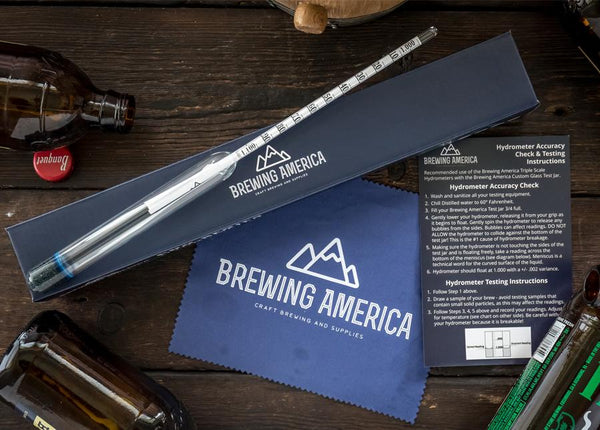
Beer Hydrometer: A Practical Guide for Using Your Hydrometer Effectively
Do you ever wonder why you see cars parked in a driveway with a seemingly perfectly good garage? Isn’t the whole point of a garage to have a place to park your car? According to research, 1 in 6 American men say their garages are a sanctuary for them. You have most likely heard such garages referred to as “man caves.”
Each sacred place these guys (and women, too!) have carefully created for themselves differs mainly according to what hobbies they enjoy doing. Some people use their garages for woodworking or metalwork. Many have project cars and motorcycles they work on, and that’s why you see their daily vehicles sitting in the driveway!
Increasingly more and more over the last decade or so, people have been using their garages to brew their own alcohol. Because let’s be honest… what’s a sanctuary without its own beer-making facility?
It may seem overwhelming to think about what products you need. You know you want high-quality and only top and trusted tools because you don’t want to make ANY product that isn’t worth the money and time you will invest in your homebrew.
Introducing… the Hydrometer
If we can convince you today to invest in at least one quality tool…let it be a high-quality triple scale hydrometer. We know times are tough right now, so we only offer the best at a price everyone can afford. We would never want cost to stop someone from homebrewing cider, wine, beer, moonshine, or whatever you want to create!
We could go on forever about this amazing tool and go full geek-mode on all the specifics, but we will just refrain ourselves!
So, What Is it?
An alcohol hydrometer is a basic tool that measures the ratio of a sample’s liquid density to the density of water. When it comes to brewing beer, a hydrometer is a NECESSARY tool that determines the number of dissolved sugars in wort or beer. The yeast converts sugar into ethanol, and ultimately, you can gauge the health and success of the fermentation of your brew.
In the brewing process, you will have two numbers that are your guideposts — original gravity and final gravity. By taking a measurement before fermentation begins and again after it is completed, you can then see how much sugar was converted into alcohol.
Why Do I Need a Hydrometer To Make Beer?
For all the time and effort (and money!) you are investing in your new hobby, you absolutely need this. Let’s be honest. Homebrewing isn’t a cakewalk. There will be many opportunities for things to go wrong. The fermentation is the most important and the most delicate stage for homebrewers and distillers. In this crucial stage of the brewing process, a specific gravity alcohol meter is the tool that will give you insight into how the fermentation process is going. This device is the single tool to alert you of issues during fermentation, allowing you to make adjustments and corrections as needed.
It is very important to measure the alcohol percentage. Especially if you are planning to serve your homebrew to guests or if you are making it for commercial purposes.
Using a precision hydrometer might seem to be a complicated procedure, but when the basic terms become clear, the math becomes simple and common. The art of making homebrew is more than just that….it is a science. Whether you are a connoisseur or just drinking your first beers, you aim to have the alcohol content just right.
Imagine being stumped when the receiver asks you about the alcohol content of your brew. That’s not a predicament you want to be in, so the most accurate triple scale alcohol percentage tester for homebrewers is a must!
Hydrometer Logistics
You must measure the specific gravity of wort to know when it has fully changed into beer. Like we said before, taking readings can seem daunting as you may be afraid to infect your beer or know the right way to do it, or worried about wasting brew. But, having the right equipment makes all the difference when it comes to taking hydrometer readings. It’s not as complicated as you might think!
How to Use a Hydrometer in Four Simple Steps:
This is the first of the guideposts testing, the original gravity. Use a beer thief to retrieve the sample of wort and transfer it to a hydrometer test tube jar. A test tube jar with borosilicate glass is the best device to use as it is strong, scratch-resistant and dishwasher safe. The testing jar needs to have enough liquid in it to fully suspend the hydrometer. After transferring the sample into the test jar, carefully place the hydrometer into the wort and allow it to float. Wait until all the air has gravitated upward. Ensure the hydrometer is centered and vertically positioned so it will display the most accurate reading possible.
Every increment represents specific gravity points. The level where the liquid rises is called the liquid-air line. Record the number on the hydrometer crossed by the liquid-air line. The typical beer wort is between 1.035 and 1.060. Every recipe is different for the specific homebrew you are making. Reference the ingredient kit for the original gravity your wort should be close to. For the most accurate measurements, read the bottom of the meniscus, where the liquid is level but not pulled up by the tension up the sides of the hydrometer or the container itself.
Knowing the temperature of your wort is crucial for an accurate reading. Accurate 0-200 proof alcohol meter readings are stated assuming a standard temperature of 15°C (59°F). If your temperature reading is different, be sure to adjust for this. A hydrometer temperature correction chart can help you.
As you did for the original gravity reading, you need to retrieve a sample of wort and, again, transfer it to a hydrometer test tube jar. Taking this hydrometer reading when the fermentation process is complete (or nearing its end) is the final gravity. The EXCITING news about this is that your homebrew has alcohol content, so it is officially BEER! Congratulations! Again, reference the ingredient kit for the final gravity to know what your hydrometer reading should be. Typical beer’s final gravity is between 1.015 and 1.005, roughly about 1/4 to 1/5 of the beer’s original gravity.
Don’t Over Sample
A common mistake many homebrewers make is testing their product too often. Each time you retrieve a sample, you run the risk of exposing your brew to air and/or bacteria, which can wreck your entire batch! It is highly emphasized and encouraged to ONLY test once for original gravity and once more for final gravity. Rarely, additional testing is needed. Be diligent and extremely careful with any extra testing.
Join the Homebrewing Movement
Numbers from 2015 indicate that America has at least 1.5 million homebrewers, and most of those are newcomers, having only taken up this new hobby since 2010.
If you are one of the million-plus homebrewers in America — or if you’re a homebrewer anywhere….Brewing America is the destination for you.
As a VA-certified veteran-owned small business, we know that quality, sustainably sourced, American-made products (priced fairly) are what you want and deserve.
